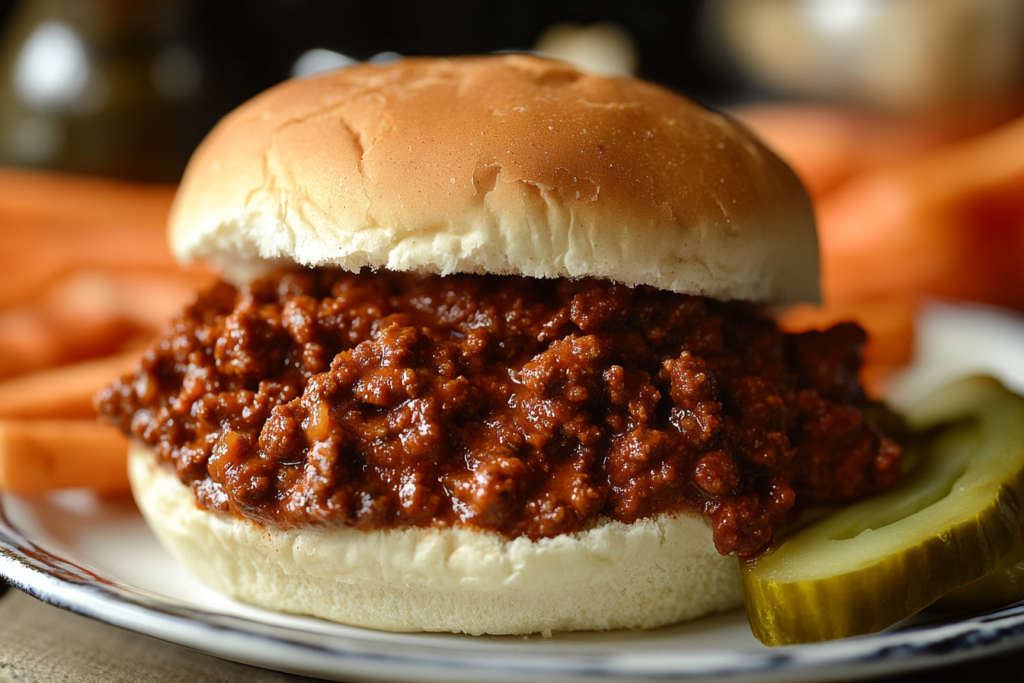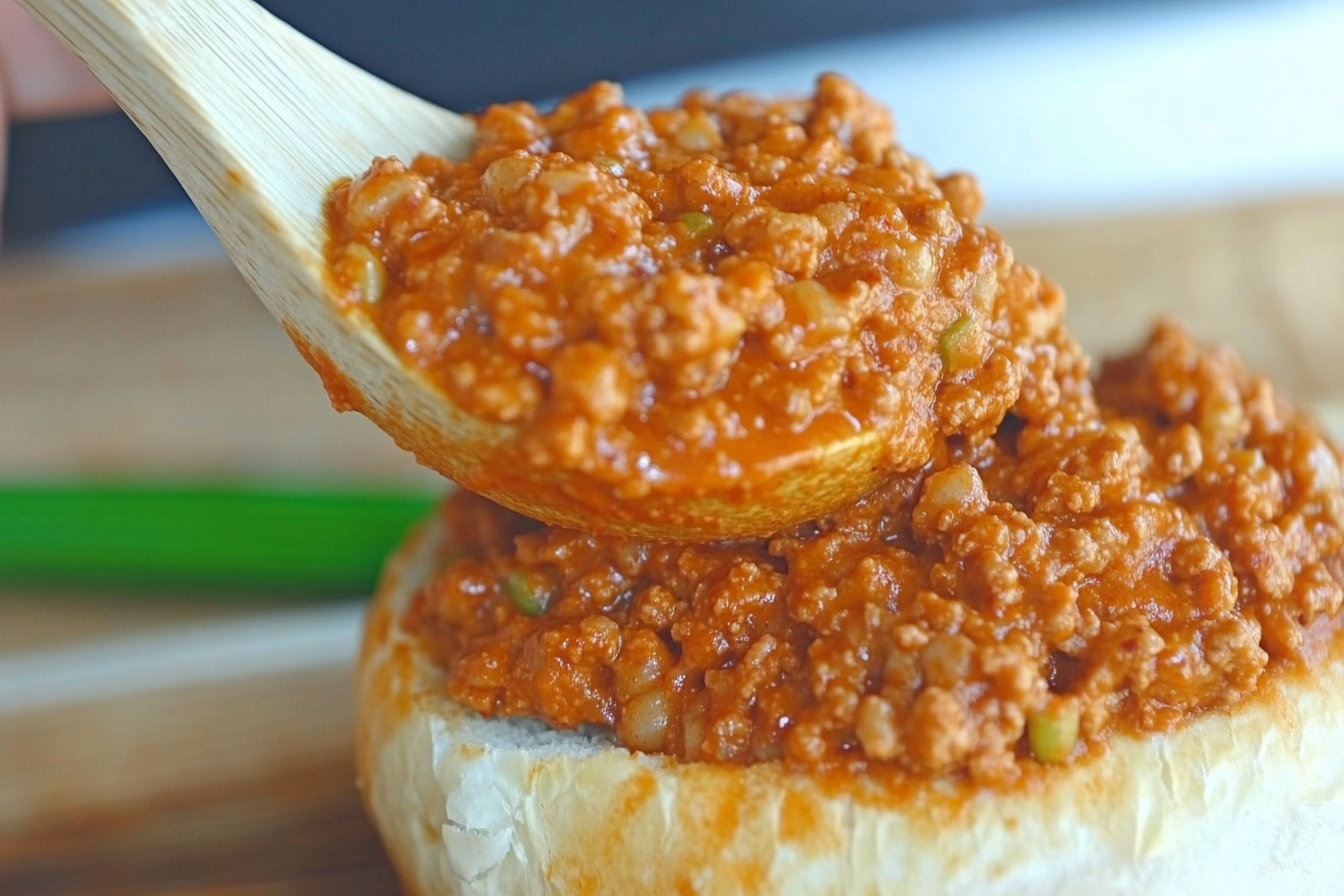Part 1: Introduction to Sloppy Joes
H1: What is a Sloppy Joe?

A Sloppy Joe is an iconic American dish that brings together ground beef, a tangy tomato-based sauce, and soft buns. This comfort food has delighted generations with its simplicity and flavor. Its appeal lies in its messy, casual nature, making it a favorite for family meals, potlucks, and school lunches.
The dish has stood the test of time due to its affordability and ease of preparation. Combining sweet, savory, and slightly tangy flavors, the Sloppy Joe is both nostalgic and versatile. It’s more than just a sandwich; it’s a cultural staple that resonates across diverse demographics.
H2: Origin of the Sloppy Joe
The history of the Sloppy Joe is shrouded in mystery, with origins dating back to the early 20th century. Some culinary historians trace it to the 1930s, during the Great Depression, when home cooks needed to stretch limited ingredients.
Interestingly, the dish is believed to have roots in loose meat sandwiches, a concept originating in the Midwest. While its exact birthplace remains debatable, the earliest iterations of the recipe reflect the economic struggles of the time, with cooks utilizing ground beef and pantry staples.
H3: The Debate Over Its Origins
The Sloppy Joe’s creation sparks debate among food enthusiasts. Iowa claims the title, crediting a Sioux City cook named Joe, who supposedly invented the sandwich by adding tomato sauce to loose meat sandwiches. However, Florida’s famed Sloppy Joe’s Bar in Key West also claims ownership, linking the dish to its eponymous restaurant in the 1930s.
Regardless of its true origin, diners and roadside establishments played a pivotal role in popularizing the dish. Its versatility made it a go-to menu item in restaurants across the country.
H4: The First Recorded Recipe
The first documented recipe for a Sloppy Joe appeared in cookbooks from the 1940s, emphasizing simplicity. Early recipes often included ground beef, onions, tomato paste, and a touch of vinegar. Compared to the modern version, these lacked the sweetness of ketchup or brown sugar.
This early recipe exemplifies the resourcefulness of home cooks, relying on basic, inexpensive ingredients to create a hearty meal.
H5: The Connection to Barbecue and Sandwiches
The Sloppy Joe shares similarities with barbecue sandwiches and pulled pork. Both feature shredded or ground meat in a tangy, often tomato-based sauce. However, where barbecue is smoked and slow-cooked, Sloppy Joes focus on sautéed ground meat with a quick sauce.
American regional cuisine also played a role, drawing inspiration from chili con carne and loose meat sandwiches. These parallels highlight the Sloppy Joe as a melting pot of culinary influences.
H6: Why the Name “Sloppy Joe”?
The name Sloppy Joe is as intriguing as the dish itself. Many believe it reflects the messy, sauce-drenched nature of the sandwich. Others suggest it’s a nod to the sandwich’s humble origins in diners, where “sloppy” food was a common term for casual, unpretentious meals.
Pop culture references further cemented the name’s charm, associating it with fun, informal dining.
H7: Sloppy Joe in Pop Culture
From sitcoms to movies, the Sloppy Joe has made countless appearances in American pop culture. It’s often portrayed as a nostalgic dish, evoking childhood memories or comedic moments involving its messy nature.
In the 1980s and 1990s, the dish gained further prominence through school lunch programs and commercialized canned sauces, making it a household staple.
H8: Regional Variations in the Early Days
The versatility of the Sloppy Joe allowed for significant regional adaptations. In the Midwest, the recipe leaned on mustard and Worcestershire sauce, while the South added a hint of molasses or brown sugar for sweetness. Coastal areas experimented with seafood versions, replacing ground beef with crab or shrimp.
These variations highlight the adaptability of the dish to local tastes and available ingredients.
H9: The Classic Sloppy Joe Sauce
The signature sauce is what defines the Sloppy Joe. Traditional recipes feature ketchup, tomato paste, Worcestershire sauce, and a touch of vinegar. The balance of tangy, sweet, and savory flavors creates a comforting yet bold profile.
Key spices such as garlic, onion powder, and paprika enhance the sauce, giving it depth and richness.
H10: The Role of Ground Beef in the Original Recipe
Ground beef is the heart of the Sloppy Joe. Its affordability and availability made it a staple during the dish’s inception. While beef remains the standard, other meats like turkey or pork have occasionally substituted, catering to dietary preferences or economic conditions.
The texture of the ground meat plays a crucial role, as it must bind with the sauce without overpowering it.
art 2: Making the Original Sloppy Joe
H1: Ingredients for the Original Recipe
The original Sloppy Joe recipe relies on a handful of pantry staples, making it easy and economical to prepare. Classic ingredients include:
- Ground beef (or a substitute like turkey for a leaner option)
- Chopped onions for flavor and texture
- Garlic for a savory depth
- Ketchup, which adds sweetness and tang
- Tomato paste for concentrated flavor
- Worcestershire sauce for an umami kick
- Vinegar, balancing the sweetness with acidity
- Mustard for a hint of sharpness
- Optional seasonings like paprika, chili powder, or cayenne for added heat
While many opt for store-bought sauces, a homemade approach gives better control over the flavor and nutritional content.
Pro Tip: A splash of beef stock or water can help thin out the sauce if it becomes too thick during cooking.
H2: Step-by-Step Guide to Cooking the Original

Cooking a Sloppy Joe is a straightforward process, making it a favorite for weeknight dinners. Follow these steps to create a classic version:
- Sauté the Aromatics
- Heat a skillet over medium heat and add a drizzle of oil.
- Sauté finely chopped onions and garlic until translucent and fragrant.
- Cook the Meat
- Add ground beef to the skillet and break it up with a wooden spoon.
- Cook until browned and no longer pink, then drain excess fat to avoid a greasy sauce.
- Prepare the Sauce
- Stir in ketchup, tomato paste, Worcestershire sauce, mustard, and vinegar.
- Add spices like paprika or chili powder to taste.
- Simmer the mixture, allowing the flavors to meld.
- Combine and Simmer
- Mix the sauce with the cooked beef, ensuring it’s fully coated.
- Reduce the heat and let the mixture simmer for 10-15 minutes, stirring occasionally.
- Serve Hot
- Spoon the mixture onto soft hamburger buns and serve immediately.
For an extra indulgent touch, add cheese slices or serve with a side of pickles.
H3: Serving Suggestions for Classic Style
The Sloppy Joe shines when paired with the right accompaniments. Here are some ideas to elevate your meal:
- Bread Options: While traditional buns are standard, you can experiment with brioche, pretzel rolls, or even toasted sourdough.
- Sides: French fries, coleslaw, or potato salad make excellent pairings. For a healthier option, consider roasted vegetables or a fresh green salad.
- Toppings: Enhance the experience with melted cheese, pickled jalapeños, or a dollop of sour cream.
Pro Tip: Serve with napkins! The messiness is part of the fun.
H4: Traditional vs. Modern Sloppy Joes
The classic Sloppy Joe remains a favorite, but modern versions have introduced creative twists. Here’s a comparison:
- Traditional Recipe: Focuses on basic, accessible ingredients. It’s sweet, tangy, and savory with minimal frills.
- Modern Twists: Incorporate gourmet elements like smoked paprika, chipotle, or caramelized onions. Some versions swap the meat for lentils or jackfruit to accommodate vegetarians.
Both versions highlight the adaptability of the dish to different tastes and dietary needs.
H5: Nutritional Insights on the Original Sloppy Joe
The Sloppy Joe may be delicious, but it’s important to consider its nutritional profile. A standard serving provides:
- Calories: 300-400 (depending on portion size and bread choice)
- Protein: Approximately 20-25 grams
- Fat: 10-15 grams
- Carbohydrates: 25-30 grams
To make it healthier:
- Use lean ground beef or turkey.
- Opt for whole-grain buns.
- Add vegetables like bell peppers or zucchini to increase fiber content.
H6: Tools and Equipment for Perfect Results
The right tools can make all the difference when cooking Sloppy Joes. Recommended equipment includes:
- Skillet or Frying Pan: A heavy-bottomed skillet ensures even cooking and prevents burning.
- Wooden Spoon or Spatula: Perfect for breaking up ground meat.
- Lid: To simmer the mixture without losing moisture.
- Mixing Bowl: Useful for pre-mixing the sauce ingredients.
A slow cooker is also a great option for making large batches and keeping the dish warm during parties.
H7: Common Mistakes to Avoid When Cooking
Even a simple recipe like Sloppy Joes has its pitfalls. Here’s what to avoid:
- Overcooking the Meat: This can lead to a dry texture. Cook just until browned and no longer pink.
- Skipping the Simmering Step: Letting the sauce simmer helps deepen the flavors.
- Wrong Meat-to-Sauce Ratio: Too much sauce can make the mixture soupy, while too little results in a dry dish.
- Neglecting Seasoning: Proper seasoning is key to achieving a balanced flavor profile.
H8: Storing and Reheating Leftovers
Leftover Sloppy Joes are a blessing for busy days. Here’s how to store and reheat them effectively:
- Storage: Place the cooled meat mixture in an airtight container and refrigerate for up to 3 days or freeze for up to 3 months.
- Reheating: Reheat in a skillet over low heat, adding a splash of water or broth if the mixture seems dry. Alternatively, use a microwave in short intervals, stirring in between.
Leftover Sloppy Joes can also be repurposed into creative dishes like nachos, tacos, or baked potato toppings.
H9: Variations Inspired by the Original
The versatility of the Sloppy Joe has inspired countless adaptations. Consider these variations:
- Vegetable Additions: Include diced bell peppers, carrots, or celery for extra crunch.
- Spice it Up: Add cayenne, sriracha, or smoked chipotle for a fiery kick.
- Global Influences: Try adding soy sauce, ginger, or curry powder for an international twist.
These tweaks ensure that the dish remains exciting and customizable.
H10: The Role of Family Recipes
For many, the Sloppy Joe isn’t just a meal—it’s a family tradition. Passed down through generations, recipes often carry personal touches, like secret spice blends or unique serving styles.
The dish evokes memories of childhood dinners, family gatherings, and shared laughter. This enduring emotional connection ensures its place as a beloved comfort food.
Part 3: Cultural and Global Impact of Sloppy Joes
H1: Sloppy Joes in American History
The Sloppy Joe played a significant role in American history, particularly during challenging economic times. Its rise to popularity coincided with the Great Depression, when resourcefulness was key to feeding families. Ground beef, a cheaper cut of meat, combined with pantry staples like ketchup and mustard, created a filling and affordable meal.
The dish became synonymous with frugality and practicality, earning a spot in school cafeterias, community events, and family dinners. Over time, the Sloppy Joe evolved from a necessity to a beloved staple, embodying the resilience and creativity of home cooks during tough times.
H2: Global Adaptations of the Sloppy Joe
While inherently American, the Sloppy Joe has found a home in kitchens around the world, with variations influenced by local ingredients and culinary traditions:
- India: Spices like garam masala and turmeric are added to the sauce, giving it a bold and aromatic twist.
- Mexico: Jalapeños, cilantro, and queso fresco transform the dish into a taco or torta filling.
- Italy: Tomato-based sauces are enhanced with oregano, basil, and Parmesan cheese, served over crusty ciabatta bread.
- Asia: Soy sauce, ginger, and sesame oil infuse the dish with umami-rich flavors, often served in steamed buns.
These global adaptations highlight the versatility and universal appeal of the Sloppy Joe.
H3: The Evolution of Sloppy Joes in Restaurants
Diners and restaurants were pivotal in popularizing the Sloppy Joe. Its casual, approachable nature made it a staple on menus across the United States. Over time, restaurants began innovating, introducing gourmet versions with premium ingredients like Wagyu beef, artisan buns, and truffle oil.
Canned Sloppy Joe sauces, such as Manwich, further cemented the dish’s place in American households. These products made preparation even more convenient, appealing to busy families while maintaining the dish’s classic flavor profile.
H4: Modern Sloppy Joe Trends
The culinary world continues to embrace the Sloppy Joe, reimagining it for contemporary tastes. Some of the most notable trends include:
- Upscale Renditions: Fine dining establishments experiment with elevated versions, incorporating ingredients like caramelized onions, Gruyère cheese, and aioli.
- Vegan and Vegetarian Options: Substitutes like lentils, jackfruit, and plant-based proteins make the dish accessible to a wider audience.
- Health-Conscious Tweaks: Recipes with lower sugar content, whole-grain buns, and organic ingredients cater to health-conscious consumers.
Social media has also fueled the popularity of these trends, with chefs and food bloggers showcasing inventive takes on the classic dish.
H5: The Sloppy Joe in School Lunch Programs
For decades, the Sloppy Joe has been a staple in American school lunch programs. Its affordability, ease of preparation, and kid-friendly flavor profile made it a practical choice for feeding large groups of children.
Over time, schools have adapted the recipe to meet evolving nutritional guidelines, incorporating leaner meats, whole-grain buns, and reduced-sugar sauces. These changes ensure the dish remains both nutritious and appealing.
H6: The Role of Social Media in Reviving Sloppy Joes
Social media platforms like Instagram, TikTok, and YouTube have revitalized interest in the Sloppy Joe. Food bloggers and influencers share creative recipes, from keto-friendly versions to indulgent party sliders. Hashtags such as #SloppyJoeRecipe and #ComfortFoodFavorites keep the dish trending, appealing to both nostalgic fans and new audiences.
Recipe tutorials and viral food challenges have further contributed to its enduring relevance.
H7: Sloppy Joe-Themed Events and Festivals
Communities across the United States celebrate the Sloppy Joe through themed festivals and events. These gatherings often feature:
- Cooking Competitions: Showcasing traditional and innovative recipes.
- Family-Friendly Activities: Games, music, and food stalls centered around the dish.
- Historical Exhibits: Highlighting the cultural significance and evolution of the Sloppy Joe.
These events not only honor the dish’s legacy but also foster a sense of community.
H8: The Future of Sloppy Joes
The Sloppy Joe continues to adapt to modern culinary trends, ensuring its place in future generations. Potential developments include:
- Sustainability Focus: Using locally sourced, organic ingredients to reduce environmental impact.
- Fusion Cuisine: Blending Sloppy Joe flavors with international dishes like bao buns or curry.
- Convenience Products: Expanding on meal kits and prepackaged options for busy consumers.
Chefs and home cooks alike are finding new ways to keep the Sloppy Joe fresh, relevant, and exciting.
H9: Sloppy Joe Branding in Food Products
Branding has played a significant role in the Sloppy Joe’s popularity. Canned sauces like Manwich introduced the dish to households that might not have otherwise prepared it from scratch. These products emphasize convenience while maintaining the dish’s familiar taste.
Innovative branding strategies, such as limited-edition flavors and collaborations with popular chefs, ensure the Sloppy Joe remains a staple in grocery aisles.
H10: The Timeless Appeal of Sloppy Joes
At its core, the Sloppy Joe is more than just a dish—it’s a reminder of simpler times, family gatherings, and shared meals. Its balance of flavors, affordability, and adaptability make it a timeless favorite. Whether enjoyed in its traditional form or as a modern reinvention, the Sloppy Joe continues to hold a special place in America’s culinary heart.
More FAQs About Sloppy Joes
- What makes a Sloppy Joe different from a loose meat sandwich?
The addition of a rich, tangy sauce distinguishes the Sloppy Joe from its simpler counterpart. - Can I make a vegetarian version of Sloppy Joes?
Yes! Lentils, mushrooms, or plant-based ground meat work as excellent substitutes. - What’s the best type of bun for Sloppy Joes?
Soft hamburger buns are traditional, but brioche or pretzel rolls add a gourmet touch. - How can I make the sauce less sweet?
Reduce the amount of ketchup and add more tomato paste or vinegar for balance. - Are there gluten-free options for Sloppy Joes?
Use gluten-free buns and ensure the sauce ingredients are gluten-free. - What sides pair well with Sloppy Joes?
Coleslaw, French fries, potato salad, or roasted vegetables are excellent choices. - Can I freeze leftover Sloppy Joe meat?
Yes, freeze it in an airtight container for up to three months. - How can I thicken the sauce if it’s too runny?
Simmer the mixture longer or add a small amount of cornstarch slurry. - What’s the origin of the name “Sloppy Joe”?
Theories range from its messy nature to its association with a diner cook named Joe. - Why is the Sloppy Joe so popular in school cafeterias?
It’s affordable, easy to prepare in large quantities, and appeals to kids.

